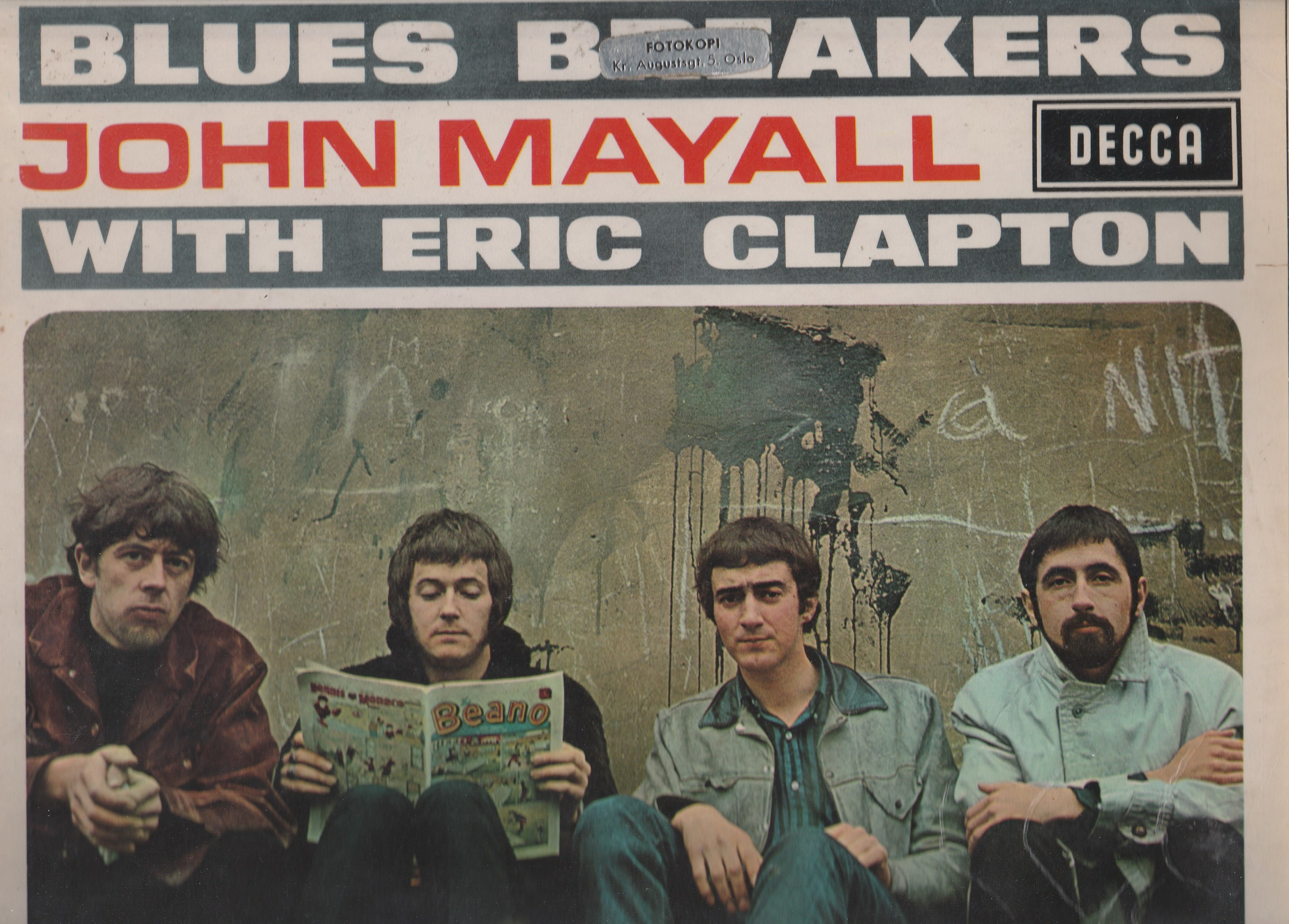
How come boys and young men wanted to grow their hair long, going against the dominant social norms in the 1960s and 70s?
They were seen as girls, devalued and unmanly. Yet long hair became a way to demonstrate a youth revolt and a counter culture.
I am reading a lot of books, including music histories, for a book project on men and masculinities, in order to understand this change.
“All you need is ears”, Beatles producer George Martin argues, regarding the success of the Beatles – the leading long-haired band.
This is a good book regarding sound – a focused yet limited regarding the artistic contribution of the Beatles (and their sound as part of their artistic intention). Martin writes a lot about the technical issues and troubles with analog recording, with too few tracks and too much noise, and the text (written in the late 1970s) is more technical than emotional.
Yet this is the text of a record producer, not an artist, and should be judged on its own merits.
Much of what he says about analog recording, written before the advent of digital recording, which emerged some years later than this text (in the early 1980ies, with CDs supposed to represent “perfect sound forever”) is still relevant and interesting today. His book gives valuable knowledge, for example, on how to set up microphones, how to adjust for different instruments, and how to get the full sound of a band.
George Martin the producer and sometime-co-musician with the Beatles was never fully credited for his work. This is made very evident in the last part of the book. His complaints are reasonable, but his nagging tone, bringing up the theme, also reminds me of other recent music books I have read, in the direction, “I should have been paid x times more”. Artists and contributors often start out from artistic and idealistic reasons, but often end up – even if they sell well (or, especially in that case) – in conflicts regarding revenues, profits and egos. With maybe the ego part the hardest territory to negotiate. Alltogether, the in-depth books I read, including biographies of rock bands, artists and producers, describe a complaint against music capitalism. You can make a hit, but from then on, you are on the run.


20 000 pupils – or more – have protested in Norway, against the lack of climate awareness on the behalf of the politicians. The protest is spreading all over the world.
Not strange – the youth are the ones who will face the costs of the actions – or inactions – we do now.
The movement, now, is much focused on the young against the old. A well known division, “age”, comes into sociological play. “Hope I die before I get old”, like the Who put it, back in the radical 1960ies. Even in gender-equal – supposedly – Norway – we get voices like way back then. “Why don’t these youths go back to school”. Demonstrating for the environment is not a legal ground for being absent, in most of the schools.
Norway seems to react like a dinosaur slightly before the catastrophy hits. It is sad to see.
Yet this is the very fare that provides the food for a new opposition, a new youth rebellion, going beyond the one in the 1960s. Now, like then, the adult world and the establishment create barriers, obstacles, and try to brush off the new insight. Later they will try to co-opt it, make it into the system in “harmless” ways – to judge from historical experience of the last youth revolt. Now it is maybe happening again. Yet these errors can be avoided. The situation is different, there is more focus, and the pupil revolt is supported by scientific evidence. The 68-ers said the whole system was bad. Now, the approach is more limited – the system is bad, if it does not correct the environment crisis.
There are plus and minuses to the “critical” approach back then – and the environmental approach now. The usual end of the story – youthful rebellions through the times – is that the youth revolt does not hold out. It has maybe some victories but mainly cultural, society is not much changed, and may even go back to worse practices due to the “humiliation” of the childish critique of the youth and its counter culture.
However, now the clock is ticking, and the expertise is on the side 0f the youth – so who knows?

I am writing a book on young men breaking the gender barrier, “looking like girls”, growing their hair long in the 60ies and 70ies. Since I have other tasks it moves ahead a bit slowly. However, I read source material, especially, music biographies and books.
Recently I’ve read Townshend, Pete 2012: Who I Am, and Cushman, Marc: Long distance voyagers – the history of the Moody Blues (vol 1 1965-1979). Both contain interesting glimpses of the aversion against young men with long hair, and the way the hair was – so to speak – entangled with the new youth culture and progressive music.
As a music sociologist, I think they err on each side of the road. The two books have two different kinds of limitations.
Townshend lays out claims that he was the first doing power chords, and came up with other inventions, but he tells surprisingly little of the musical development in the band and how this impacted on the band relationships. It is more like, this band mate was strong / not so strong.
Cushman’s first part – a massive volume on the Moody Blues, will there be a second? – on the other hand, goes all into the music. The social context is more sparse. And the text uses a lot of space for listings of the band’s record sales, rather than the music itself. Nevertheless, it is clearly the new standard of scholarship on this band. Yet even here, I would have liked better analyses of what exactly the Moody Blues did, that was musically new.
Plus points in Cushman’s book include glimpses of Ray Thomas as alto flute player (and other musicians in the band) combined with the production talents of “the sixth moody” Tony Clarke. The credit to Clarke is well deserved. Decca was quickly learning and developing production technique developed at EMI (Abbey Road), and had very high standards from earlier recording also, surpassing EMI in some respects.

Cusham is great on how the Moodies – this unlikely bunch of old-style-singing long-haired guys with somewhat uncertain instrumental prowess – were allowed into the Decca “holiest of holy”, with the new Deram sound system (DSS), using two four-track recorders for better stereo. The band was supposed to play classical easy listening music. They barricaded themselves in Decca’s best studio, and ended up inventing something new, in the typical spirit of the day. The result was Days of future passed, one of the larger-selling LPs of all time.
Townshend mainly tells his own story, and somehow, I find the connections to the music rather weak. Fans of The Who may love the band for “inventing” this or “doing” that, but what actually happened, musically? Maybe this critique is unfair. Townshend does tell about his attempts to go further, to develop music beyond what the band had done so far. Later in the book he says that the band had done a lot of jumping and showing off, this would not do anymore.
Inadvertently he also tells a story of how “youth” wasn’t a staying ground for the attempted change.
I would have hoped Townshend took some self-critique for lines like “Hope I die before I get old” – but it is only implied. Like, maybe we DID smash up a few guitars too many. This is the tone of the book, as I read it. Townshend’s book has elements of defense that I won’t go into here. Maybe it spilled over, also into his judgement regarding things back then. Maybe a revised version could work this out better.
Bands like The Who took the “soft” message of the youth revolt and the counterculture, and “hardened” it. What happened, in that transition?
Cushman is fine on the music, but the wider social context, culture etc is often largely absent. How come these nice Birmingham lads, singing in almost 1950s style, were tuned on to the new youth rebellion and counter culture? I wasn’t much wiser, even after 700 pages.
Was the Moody Blues, on the road, a much more orderly affair, than The Who? Less misogynism and use of groupies? It seems so. The books show that male bands could have quite different wishes and setups. Although the different filtering of the story telling applied by the two authors may play a role.
Was the creative process of both bands hindered, by the music industry, the emphasis on commercial hits and best-selling albums? Again, it seems so. Despite variation the basic story is remarkably similar. Did this, all in all, create a more “masculine” idea of music? Now we are into speculation territorry – but it may seem so, yes. In various ways. Ending with the synth-pop of the 80s. Long-haired bands becoming dinosaurs, one way or the other. In fact, you maybe don’t need Reagan or Thatcher or digital sound problems into the equation, to predict the generally agreed-upon “bad sound of the 80s”. Just add “band pressure” working over time.
For example, listen to Moody Blues: Octave album, Steppin in a slide zone (1978). This sounds so bad, it maybe sounds great. If you like the 1980s sound. The flat synthetic sound reminding me of shoulder pads for men. Short hair once again. A kind of prophesy of the 1980s music letdown. Was Clarke out to lunch? Anyway, almost everyone agrees – with Octave, we are no longer into the “classic” period of the group. Artistic quality is falling. Why? Constant pressure from a commercial machine is – broadly – the best answer.
Octave was made after the group was totally exhausted, having made seven albums, later called “the classic seven”, in a period of nine years. Likewise, the Who and other groups were pushed beyond their limits, by very high demands from the record companies – entangled with their own wishes to make money, while the attention was there. “Do it now”, like Paul McCartney advises on Egypt station. Everyone remotely musical and socially engaged, 1965-75, felt like a storm was coming on, a counter culture expressed especially in music, a new truth that could not be denied, or at least, a new level of public discourse, an extension of democracy, “love” as in empathy, etc. So – the behaviors and conflicts of the bands – can be read in this larger perspetive, they were a new type of organizations, that tried to spearhead the youth revolution and the counter culture, but encountered great costs along the way.
Both books are well worth reading, if you are interested in this period, and its wider repercussions. They both give some guide into what to listen for – albums, songs – and a musical follow-up is interesting.
Best place to start with the Moody Blues is maybe To our children’s children’s children (1969), perhaps the most successful of their classic seven albums. Then try Questions, on A question of balance (1970). If this doesn’t rock you, nothing will.
:format(jpeg):mode_rgb():quality(40)/discogs-images/R-3571823-1378397821-2878.jpeg.jpg)
Best place to start with The Who – I have not decided yet. Listening to Tommy and Quadrophenia, The Who sells out, A quick one. The early stuff is often the most interesting. Maybe all in all the best intro, to get the feeling of the band, is The Who sells out.
:format(jpeg):mode_rgb():quality(90)/discogs-images/R-2229657-1338708241-6734.jpeg.jpg)

It feels strange, now, looking at a book I wrote many years ago.
The cover by Klaus Nordby is great – one of the best I have had, on the books I have published. You can see a key as well as a broken heart.
My own bookshelf copy is pictured here. It has been useful, opened many times.
What does the book say? Well – read it!
It is in Norwegian, and the title – translated – is “Dating, love and the gender market” (Sjekking, kjærlighet og kjønnsmarked). Pax, Oslo 1981.
The title starts with the Norwegian word “Sjekking” which is not so easy to translate (literal: checking, checking up). “Dating” is not quite precise, especially as it relates the practices in the US that were never common in Norway. Picking up a partner is maybe more realistic, on the whole, but the English words are not so clear.
There was a Swedish translation of the book (Hammarstrøm och Åberg, 1983) – using the word “Raggning” for the Norwegian “Sjekking”.
The cover (by Johan Petterson) shows another angle – a kiss above, a jungle below.
Note those eyes…
Sadly, the book was never published in English.

Cream once more
Reading Dave Thompson: Cream – the world’s first supergroup. Virgin books, London, 2005
I put on some relevant vinyl albums, to test his hypotheses.
The band sounding very good indeed on live concerts, Thompson claims. I put on Live Cream, volume 2 (RSO 2394 155) – yes this is true. On some tracks they sound better live, than on their studio albums. Do they need an organ (which they worried about) – no. I note that bassist Jack Bruce takes over much of the stage, and yet this is contested by the two others – as interpreted by Thompson.
In some long instrumental tracks, Clapton mainly plays with Ginger Baker (on drums) while Jack Bruce (bass, vocal) shuts up. Baker heightens Clapton’s playing beautfifully, increasing energy and light and darkness where needed.
I listened to the “Beano” album (1966), and then John Mayall’s solo album (1967).

Again, Thompson’s interpretations are in line with mine. Thompson’s first 70 pages are focused on the UK blues scene before the arrival of Cream. This is very useful, and spot on, as far as I can tell.
Example: I first heard the Beano album way back when, with my cousins, in ca 1969, on a small Phillips Bambino record player. Even with this tiny player, we were mesmerized by the tone of Clapton’s guitar, from opening track “All your love” onwards.Thompson details how Clapton had to struggle, to get this “overdone” guitartone accepted, in the recording.
Cream was created as very fragile compromise (the group only lasted two and a half years) going beyond the music up to that date (1965-66). It was like opening a time window.
When the group got lyrical assistance from Pete Brown, they started the venture. They strutted their musical stuff on the debut album Fresh Cream (1966), but their main progressive thrust forward was the next Disraeli Gears album (1967), followed up by the halfway succesful double album Wheels of fire (1968) and the so-so Goodbye album (1969).
Thompson does not note that some of Mayall’s songs were pro-feminist. Or at least, proto-feminist, compared to the standards of the day.
On the Mayall and Clapton “Beano” album, his song “Little girl” is about a woman who has lived 18 years in bad relations. Mayall is out to rescue her. Is it “pastiche” or just riding with the options of the day? Maybe somewhat, but on the Blues alone album, a bit later, he is more explicit, on this front – especially in the “Broken wings” song, maybe the best on the album.

“Somebody broke your wings”, he sings, telling the story of a woman. Mayall does not try to intervene as savior. Instead the song is a beautiful attempt to do what Kate Bush (Hounds of Love, 1985) called for later – if I could be in your shoes, climbing up that hill – trying to be in the other person’s place. Shifting the gender perspective. Reminding me of Donovan – although the two started from different musical grounds (folk vs blues).
Another follow-up of the pre-Cream scenery detailed by Thompson was the band Colosseum, with Jon Hiseman on drums. I would not say he is better than Ginger Baker in Cream – rather, he is (at his best) in this same “creamy” class, like in their most well-known prog rock cut, “Those who are about to die”. Here, you can hear many jazz-rock attempts get to frutition, based on a good prog song concept, and – not least – the drummer Hiseman propelling the band forwards. The great horn-blower Dick Heckstall-Smith and the others get air under their wings.
This is a song about – basically – freedom from slavery. Other songs were about freedom from other forms of oppression. Including gender oppression. This was the spirit of the time.
This social awareness – in my opinion – was what pushed the music forwards – opening the “time window”.

Paul McCartney’s Egypt station lights up like nova and will become a classic record.
Yes some songs (like Fuh you) are silly and in the “old man gets it up” category. But they are made with a joke. They are parts of a serious album of surprising strength. Made in senior days, reminding me of Dylan’s Time out of mind, showing what a great artist Paul McCartney is, beyond any form of classification; inventive and communicative. Even in his vaudeville and sing-along songs on the album, there is a coherence and sense that it fills a whole. “If you come on to me I will come on to you”. There is an old man trying to get it all on record, before he dies.
The nadir is Despite repeated warnings, a small symphony, and the best potential single is Dominoes. It all works up to a coherent unity. Listening to the album, I found it did not leave me, it would not let go. Over time, different songs on the album came into my mind. A grower, like they say.

Screen capture showing Commence with my calendar, contacts and research references windows open
“Commence” (or “Commence RM”) is a program in the somewhat quaint category called PIM – a personal information manager. Now, why would I need a personal information manager? It was big news almost thirty years ago, running the newly developed Windows operation system, at that time called “Current”, developed by IBM engineers. But today?
My method was to use the program in my own way. I liked the “personal” element, even if Commence mainly was developed in a commercial direction, as help for sales management. I used it as a researcher. I built my own research literature reference database in Commence long before Endnote came along.
I bought the first version of Current (https://en.wikipedia.org/wiki/IBM_Current), not least due to an enthusiastic review (I think it was in PC Magazine) – this is not only personal, it enhances the power of the user, in line with “the PC revolution” – a term still very optimistically used at that time. But I have not regretted, since.
After some quarrels (“why do you need this when we have Outlook”, etc) I’ve usually been able to get my employer to pay the cost of upgrading. I have succeeded in convincing my managers that this is an advanced tool that I need in my work. Why? I have a lot of extra information along. Not just the capability of e g Outlook to connect meetings and times. The PIM category was created from the ground up to support four main categories of information – time, meeting, note, to do. Current / Commence does this from the start, it is built around this core. So it is possible to use “as is”, and it can be tuned and developed, for further benefit.
So what is the plus, and the minus? Minus first: expect a learning curve. Yes, you can set up your own databases, and get them connected to the calendar function of the program, or other data bases, when needed. But it takes some time to learn how to do this, and some of the user interface, for example for setting up “Agents”, programmable functions in the program, is not very good. The big plus is that it works. Once you have set up something successfully, it seldom breaks down due to bugs. The program is very stable. It is also remarkably fast. Searching through the data is very quick (and you can do a search through all your data bases).
Some concepts must be learned – Commence lets you set up a database under the term “Category”, and each category has “items”. So my literary database has books and papers as items. You can connect categories to each other. My “Music Works” category has connections to my “Artist” category.
When you learn the basics of it, and have set up a few of your own databases – you will discover that Commence is extremely flexible, in the ways you can work with it. For example, I have 3000 items in my book base, 1500 in my music database, and 500 in my product base. Database items can be imported into Commence, or created there.
How can I get the information from each of these bases / items? Not just by opening the program and having a look, from a quite good user interface. But also from other programs. I can use an old but still functional mechanism in Windows called DDE (dynamic data exchange).
So from a Word macro, for example, I can ask for an item, or list of items, from the Commence database. You can also use the Commence API, and program it, from some other type of code, in Visual Basic, for example. If you know how to use Commence, and the basics of a programming language like Visual Basic, it is not very difficult to extract or input information in Commence. Commence also has “scripting” options, so that you can get some data base behaviour for free – fill in this field, and that field will also be filled in, and similar. And as mentioned, you can have Agents that are called from other programs (or from within Commence) to perform batch operations – a series of commands.
So for flexibility, the program scores top – just like it did at the start. It is a kind of “Lego”. You get a lot of building blocks.
Even if it requires some effort to learn and to adjust for personal needs, the program has given me real improvements reducing time for “look-up” type of work. It is like having some extra pockets, for information.

HMS Donovan
This is one of the unknown treasures from way back then – 1970. Donovan was taking a shot at Sgt Pepper, starting from children’s songs. The music is just as amazing as the cover.
Donovan is an underrated artist, part of the youth revolution in the 1960s, and though somewhat “cosmological”, also quite wise (followed up e g in Sutras, 1996). His best guitar work is unmatched to this day, and shines through here.
Donovan, just with his voice and acoustic guitar, can take you away – like no one else.

Photos by Øystein Gullvåg Holter
Young girls in the parade

The placard reads “Pride. We still have a way to go”. Men were involved too, but more reluctant, like this picture suggests.
Displayed in many ways
Her placard reads: “Old gays love best”
There were expectant groups of bystanders along the way of the Pride parade, like here
And here
New meetings happened along the way
Seniors participated also
Sisters on the move (“Proud sister”)

Sociology and reciprocity (1997)
Reproduced on demand. Appendix 3, page 559-68, in my Dr. Philos. dissertation, Gender, Patriarchy and Capitalism – a Social Forms Analysis, The Work Research Institute, Oslo 1997. Original text follows.
– –
Appendix 3 Sociology and reciprocity (1997)
Introduction
This appendix discusses some methodological points of social forms analysis, and some sociological perspectives on reciprocity, including Gouldner’s and Baudrillard’s views. Due to considerations of length, a draft on various sociological traditions concerning reciprocity (Simmel’s reciprocality, Weber’s rationality, Parsons’ normativity, action-theory and life-gift views, neo-positivists, Habermasianists, materialist feminists, etc.), has not been included here.
Structures, reciprocities and life worlds
During the 1980s it became common to criticise structuralist and institutionalist views, and the radical 1970s structuralism especially, for neglecting the individual actor, to the extent that ‘structure’ itself became disreputable. It is still often argued that a structural view, must include an assumption that individuals are ‘determined’ and can do nothing to change their world (Skjeie 1992:19). I disagree with this view for several reasons.
Much of what came into disrepute as structural determinism was simply another line of action, usually a more radical one than the ones favoured by the individualist critics. This is fair and well, but it concerns two lines of action, not inaction versus action.
No amount of structural theorising by itself negates or opposes individual action. The argument that there is rough terrain ahead does not by itself translate into an argument that people should not attempt to move forwards, or are not doing so already. That idea is comparable to opposing diagnosis to treatment as if contradictory in principle. Structural views must be evaluated on their own grounds. What do they tell us of society’s structure? Is this true, or is it not? Their capabilities for interpreting individual action is a different issue. The diagnosis may be bad, the treatment good, or vice versa; we cannot directly infer one from the other, even if there is often a correspondence.
A structuralist view easily becomes misleading if not connected to a view of institutionalisation and interaction. The link between individual existence and societal structure becomes meaningful and comparatively directly observable mainly on the institutional level, or what Robert Merton (1949) called the ‘middle range’.
It may be objected that structural categories are also easily static categories. In view of the radical structuralist and critical theory of the 1960s and 1970s, the problem was not that it discouraged action, but that it did not sufficiently focus on the responsibility of the individual and on individuals’ actions, pointing to its lack of emphasis on democracy in this and in many other related respects. Yet nothing of this does away with social structure as such.
Analyses oriented towards individual action always presuppose some concept of interdependency; if this is not stated, it usually means that a market-rational or utilitarianist framework is brought along as a matter of course. In other variants, especially mid-century sociology, a normative framework with more redistributive aspects lie in the background. Whatever the case, these must be made explicit, and this issue becomes acute in gender studies, where the conflict, precisely, is often one of different reciprocity conceptions. So actor- and individual-focused methods may certainly be of help explaining gender-related actions, but less so if structural constraints, including reciprocity patterns, are ignored.
Structure by itself, in the sense of the ‘structuralist school’, is not a main issue in social forms analysis, which instead is process-focused and activity-oriented, using ‘code’ and structure categories mainly in that context. By investigating transfer and reciprocity patterns in social interaction, the focus is shifted towards the background foundations of institutions, not as a matter of (natural) stasis but as historical processes. This is combined with minimalism regarding supposedly universal categories, since these are always to some extent misleading and easily projective. While the ‘kernel code’ should be as small and generic as possible, theories can be seen as ‘modular’, made up of modules around this kernel. Why should the kernel be small? Social life has a bad habit of departing from any pre-given category or notion.
This approach is very different from the traditional structuralist view, including much critical theory and many interpretations of Marxism. It is the social and historical engagement of a category that mainly points to its usefulness, and not its pretensions towards universality, which is usually where the ideological aspect comes into it. True, even a minimalist view, in the sense described, contains some pretensions in this regard, as discussed in the text (chap. 7), yet the emphasis and line of approach is different. The idea is not to find a holy grail of conceptuality, everlasting categories that stand above life and history. It is not to ‘subordinate’ current gender or other phenomena into some larger, enlightened ordering of gender, as a subcase. On the contrary, an ‘extensional’ or contextual interpretation of social concepts is used precisely to move beyond that stage.
What we often find, then, behind a separated higher stratum of abstract reasoning, performing a work which is basically of ‘heroic’ nature, claiming eternal truth-value, is masculinity ‘neutralised’, abstracted, or sublimated, with a real life pattern and social context behind it. Unlike some feminists, I am not saying that nothing good comes out of this, and unlike ‘total’ relativists or theoretical nihilists, I am not saying general categories are simply fictitious. On the contrary, we can appreciate their true generality better by moving beneath their abstractist layer, uncovering the engagement, concern and struggle that usually lie behind it.
Whereas traditional materialists argue that individuals are dictated by material circumstances and interests, the social forms approach to materialism is more complex. Social life indubitably is material, yet the material as such has no pre-eminence in this framework. Instead tradition or culture in the wide sense of ‘past results of human activities’ is granted influence, since it tends to pattern action, or create a meta-layer of precedents. This ‘sociomaterial’ (as Dag Østerberg calls it), however, becomes more or less effective through its ability to link up with current processes. It has no weight on its own, and the same is the case with ideas. We do not stay within the materialist / idealist framework of discussion; rather, this whole framework is interpreted as part of a specific social form context. Although material circumstances are important on a general level, not much can be said, or inferred, at that level, due to its ‘abstractism’.
The ‘elemental’ logic of this link is the transfer, not narrowly defined as the transactions necessary for life, or as distribution, but as a wider concept of the connecting of past life for creating present and future life conditions. The entities transferred are past life in fragment form, through a certain ‘code’. Many social contexts can be understood by examining these transfer codes as well as the attempts to transcend them; what they mean, how they work, how they act together, what is pushed upwards or ‘sublimated’, ‘abstracted’, and what is hidden below.
Therefore, the present text might also be approached from a methodological individualism angle. I start with not only with individuals, but with individuals doing their best to be or become ‘really individual’, to get out of the queue of anonymous existence, for the purpose of loving one other person uniquely and personally. Yet all this individual uniqueness, brought together, ‘publicised’ in partner selection patterns, has not straightaway taken off from society. It remains dependent on structural constraints, being significantly influenced both by exchange patterns, which is what people commonly start off from, and by gift and sharing patterns, which is where they want to go. “Gender”, in this perspective, is what people make out as, in a certain setting where choices are limited and structured in a specific reciprocity context, extending into a cultural and societal cycle of opposed reciprocities, what I call a ‘polarised’ structure.
Social forms analysis does not conceptualise life patterns or ‘life worlds’ as virginal areas or petit-bourgeouis zones about to be intruded on by society’s systems, like some currently popular paradigms. Once more, an idea which is ‘latently’ misleading becomes acutely awkward in the gender area. Jürgen Habermas’ portrayal of a life world outside society – besides being an updated version of the Victorian theme of the home / the woman as ‘moral elevator’ for the man / the market – tendentially absolves individuals of societal responsibility. I also find that it represents the neutralised masculinity theme introduced above. Although indirectly quite indicative, therefore, of a certain gender-related development, it remains the case that Habermas’ theory (e.g. Habermas, J 1989) is somewhat ‘blind’, to put it mildly, on that point (for a Marxist critique cf. Postone, M 1993:235; for a defence cf. Bohman, J 1989; Carleheden, M 1994). In some feminist views (e.g. Fürst, E 1994:164) the colonisation of the life world is another term for ‘the increased dominance of exchange value’. Others (e.g.. Carleheden, M 1994) find ‘the paternalistic state’ in this role. Whatever the case, it is ‘out there’, and it is precisely this kind of theorising that makes it anti-feminist in tendency.
Life worlds change with social worlds, and are as much a part of the latter as any ‘macro’ phenomenon of society. Families and factories, as we know them, in their modern sense, were created together, closely interlinked, in tandem. The idea that human nature stays apart, as a subject to be located in some ahistorical realm, while society changes historically, is one main barrier that hinders an understanding of how they change together and how they influence each other. Society never ‘intrudes’ in this sense: it is there all the time.
Functionalist sociology and Gouldner’s ‘norm of reciprocity’
One of the main contributions to the sociological understanding of reciprocity come from Alwin Gouldner’s well-known papers on the subject (Gouldner 1975). Before I discuss these, something should be said of Gouldner’s general approach (or his approach until the mid-1970s), and the way it differs from a social forms approach. Today, functionalism is often criticised in an ‘as such’-approach, as if functionalism as such lead research astray; yet I believe that a functionalism like Gouldner’s may often be more insight-giving and imaginative than the later alternatives (that in fact also often turn functionalist when they try to explain anything). It often precisely where I disagree with functionalist explanation that I find it most fruitful in this wider sense. For example, in the case of Gouldner, society is basically explained in terms of social norms, which is not my view. Yet one cannot fail to see that this is where his associations become most interesting, here he is free, so to speak, on his home turf. He is often better discussing the normative level of reciprocity (or the transference level in my terms) than he is discussing reciprocity (the transfer level) itself.
In the 1960s and 1970s, Gouldner’s radical functionalism advocated a critical, political, humanist sociology. Gouldner argued against value-free, positivist theories of science (1975:3pp.). Yet his method is meta-positivist in the sense that even if it arrives in a critical or radical position, the approach itself in major respects does not differ from that of the positivists. Consider the following statement:
“Generically, the norm of reciprocity may be conceived as a dimension to be found in all value systems [by which he means normative systems] and, in particular, as one among a number of ‘Principal Components’ universally present in moral codes. (The task of the sociologist, in this regard, parallels that of the physicist who seeks to identify the basic particles of matter, the conditions under which they vary, and their relations to one another.)” (Gouldner 1975:242).
The method of Gouldner (and of his opponents) is brought forth here.
- There is the implication, first of all, that the social is not what is changing, but that which does not change. Change is secondary, a dependent variable or property of the social, after the sociologist has identified patterns that exist above the level of historical change.
- Since the social, in this concept, does not change, it is not principally distant from, or different from, that part of the social that the sociologist happens to be in. The text is not to be read as an expression of its real context, the actual context of the sociologist writing it. Instead, the sociologist has an immediate conceptual access to a room of unchanging, universal traits, an as such-space which is beyond historical time and space. Certainly, for Gouldner, more than for his opponents, sociological theory reflected the conditions of the sociological theorist; this was one of his main points. Yet it remains a very limited ‘reflection’; it is not a property of the basic epistemology, but rather the ways in which it is used. Therefore the debate was not about the as-such-space itself, but rather one such space posited against others, like Parson’s view of normative congruency (one universalist space) as against Gouldner’s view allowing more conflict, discongruence, dysfunctions, etc. (another universalist space).
I believe that this presumed immediate access has been a main temptation for many sociologists, a conceptual ‘stairway to heaven’. As argued, it is not just a false-leading temptation, but also often one that makes their work interesting reading. The results may in fact be more interesting and indicative when the sociologist tries to universalise, say, American middle-class 20th century values and lifestyle, than when she or he is at pains not to do so – and often for the reason noticed; one is ‘securely grounded’, some imagination is therefore allowed also. Yet there remains a basic problem with this approach. There is a false security involved; the method does not require a continuos self-correction and critique as part of the process towards approaching more general traits of social systems. Gouldner, for example, does not conceive of the sociologist looking for basis-traits of people, like the physicists looking for basic particles, as reflective of something beyond itself, as indicative of a particular context of people, and those about to ‘know’ them; rather it just is, as the way to scientific knowledge.
- Therefore Gouldner does not feel the need to ask himself how it is that this method – which even at the face of it is somewhat awkward, since people change all the time – seems true and natural. There are no checks in this kind of theory, between the real context, and the assumed universal context. This kind of checks, signals of when to stop, to reconsider, is what social forms analysis tries to contribute to, by extending a critical approach, by building on the best of Marx’ value form theory but also going beyond it, by incorporating gender and a broader, multidimensional participatory view.
- When considering the norms of reciprocity and beneficence, therefore, Gouldner’s method does not tell him, first, to carefully trace the modern connections of his analytical apparatus; there is no idea that what seems most universal, on this horizon, may be, precisely, the least universal part of it, due to the abstraction process of capitalism or for other reasons. So, for example, Gouldner in discussing the reciprocity relationship argues that whether the donor gets the economic equivalent back is simply an empirical question (1975:243), failing to see that this question lies at the back of his own analysis, indeed that it often appears as the greater ‘anxiety’ to which the analysis is an ‘answer’, in the sense of ‘symptom’. Gouldner’s method does not lead him to question the commodity form framework of his own sociological imagination, before dealing with presumably ‘other’ kinds of relations – even if he would probably agree to the centrality of the commodity in the modern world.
The idea that societies are ‘value systems’ generated by norms is idealist. Yet Gouldner might as well be a materialist arguing that norms are governed by material factors (and in a way he is, since in functionalist theory norms are generated by ‘system needs’ that are at least semi-material). It is not what or who governs, but this governing of social life itself which is the basic issue.
- Thereby, also, the political aspect of meta-positivism comes to the forefront, as a science of variation within the status quo, or as some would say, co-opted change, allowing endless transformations within the larger stasis. Whereas people live their lives, i.e. change, the sociologist is the one whose ‘direct access’ turns into a power access, an access to the powers that be, that hinders change. The ideological, legitimatory ‘function’ of meta-positivist sociology thereby becomes clearer, as the ‘universal’ space of discussion, surprisingly, also turns into the ‘power place’ of discussion.
I shall turn to Gouldner’s portrait of reciprocity, which he sees as a norm existing together with two other norms, one of beneficence, and another of moral absolutism or supernatural sanctioning, which primarily enforces the two former norms. The three, he believed, are present in various degrees in all social systems. From this perspective, he criticised Mauss for overlooking ‘the norm of beneficence’ and for not distinguishing between the intention of the donor, which may be beneficence, giving something for nothing, and the common consequence of giving, a reciprocal relationship of ‘something for something else’ (1975:298-9).
The history of how Mauss and the anthropologists after him changed a ‘giving’ perspective into an ‘exchange’ perspective on the gift, is highly interesting, as Gouldner (1975:298) retells it:
“Bronislaw Malinowski had, in his earlier work, spoken of the gifts given by a husband to his wife as ‘free’ or ‘pure’ gifts. Mauss, however, in re-examining Malinowski’s own data, had noticed that, in due time, some return was in fact given the husband: women returned their husbands’ gifts with sexual favours. Consequently, said Mauss, the husband’s gift could not be called ‘free’ or pure since it did bring a return.
In his own Essay on the Gift, Mauss stressed that there is a culturally pervasive rule which requires that those who accept a gift must later return it. He therefore concluded that what had appeared to Malinowski to be a case of beneficence was, in reality, a case of reciprocity. Interestingly enough (..) Malinowski accepted Mauss’ criticism (..), the only party that might have suffered from this entente cordiale was social theory. [Gouldner goes on to comment on a scientist agreeing to “deeply dubious” criticisms of his own work as if that was “a very unusual case”]. Basically, Mauss had correctly sensed the functional interconnection between beneficence and reciprocity; but he failed to see and to work out the conceptual distinctions between the two.”
One would agree with Gouldner that this criticism is deeply dubious, even if it is not at all unusual that conventions, power, etc., make researchers turn their back on earlier discoveries (cf. Barry’s paper on Otto Rank). Moreover, the whole case of the enlightened liberal gentlemen’s agreement on this point – i.e. a point where women make pure gifts into something more merchandise-like, by their returning ‘sexual favours’, is probably better explained by the modern context of these men and their theories and their views of women and sexuality, than anything else. Those who seek, will find – in a love relationship there is of course ‘returns’ of all kinds; anything can be seen as a ‘return’. If Gouldner is right, giving as the logical verb of ‘gift’ was turned into exchange due to this ‘minor matter’ of women’s ‘sexual favours’.
Gouldner’s (1975:277) portrait of the relationship between the norms of reciprocity and beneficence is of relevance for the distinction between transfer and transference. After describing various system-enhancing functions of the norm of beneficence (turning “domination into hegemony” and “merely powerful strata into a legitimate elite”; creating “outstanding obligations” and “social debts yet to be discharged”; preventing the “squaring of accounts” and “vicious cycles” of retaliation; and serving as a starting mechanism or “ignition key” for the “motor” of reciprocity), Gouldner notes the paradox that
“there is no gift that brings a higher return than the free gift, the gift given with no strings attached. For that which is truly given freely moves men deeply and makes them most indebted to their benefactors. In the end, if it is reciprocity that holds the mundane world together, it is beneficence that transcends this world and can make weep the tears of reconciliation.”
This describes a special type of transference, in a particular transfer context, yet it serves to illustrate the general principle that people are indeed moved by transferential patterns beyond the transfer itself. It is not the act of giving, by itself, which is special in the case he discusses, but the larger meaning given to it. The transference level of analysis points to the fact that this meaning is always there, even when there are no ‘tears of reconciliation’.
Although Gouldner’s writings on reciprocity went beyond the ‘exchange’ perspective of Mauss and Malinowski, he is still focused on one main question, namely what the gift can return, what it will bring back. The free gift, as we just saw, can be the one of the highest return. As mentioned Gouldner does not address how such assumptions are part of a specific moral universe. He discusses reciprocity on an implicit background of commodity exchange, a world of scarcity and individual actors whose obligations are centred on the dyadic reciprocity relation. The natural consideration of a donor, therefore, is what he gets back, if only in terms of the further effects of beneficence. Yet this may be a very secondary consideration if the donor’s context is, indeed, that of a gift system, a redistributive system, or some combination of the two. In that case, the ‘receiving back’ function is often already taken care of by an elaborate set of rules that ensures, for example, that the donor anyway receives his part of the daily consumption, for example as part of the sacrificial offering which is ‘given’ to the deities and yet mainly consumed by the sacrificers.
This is also the reason why Mauss’ presumed universal rule, “that those who accept a gift must later return it” (op.cit. 298), is true only of some types of gifts; in early Greek traditions, for example, we find gifts that should be passed on to a third party (following a ‘not to touch the ground’ principle, not to be stored), gifts from the far periphery that were not returned, one-way sacrificial gifts, and much else, that was object to other rules. Westermarck’s more cautious observation (quoted on p. 242) that “to requite a benefit (..) is probably everywhere, at least under certain circumstances, regarded as a duty” seems more correct. The point, however, is that this ‘requital’ does not need not be in the form of a return, or conceptualised in that manner, and it does not need to be directed towards the original donor(s).
Gouldner does admit that the “reciprocity complex” is more extensive than the part of it that he examines, “the generalised norm of reciprocity” (op. cit. 246). Yet within this framework his reciprocity relationship resembles a ‘delayed commodity exchange’, with a loose and rough account rather than precise reckoning. It remains within a universe where the stress is on the direct relationship, donor to recipient, A to B, and not this relation as one of many others in a socially organised whole. In the latter case, “receiving back” is often irrelevant, since there is a whole string of gifts and redistributions, and a “politics” which is far more complex than this question would imply. A gives to B, B to C, and so on; simultaneously there may be a redistributive relationships between them; it is easy to see that such a complex pattern of interaction – beyond the dyadic logic of commodity exchange – also calls for far more complex strategies a considerations. The premise of scarcity, and the connected idea of utility (in a reciprocity relationship, Gouldner believes the self’s “right to exist is dependent upon and must be continually renewed by its demonstrated utility” (1975:269)) aren’t independent of the social form and cannot be taken as a priori ground rules.
If the transfer relation is often a dyadic relation between two parties, we may say that the transference field relation is in principle triadic. And that is even a poor way of stating it, for it is not only that a transfer relation A-B is here conceptualised in relation to some third matter C, but more, that the whole dyadic relation is reinscribed within a larger and much more complex relationship C. “Reinscribed” seems a fitting word here, for the dyadic character of many transfers may indeed be seen as “expressions”, or fragments, of a larger whole. This redefinition in terms of larger matters do not imply that transference is necessarily a more abstract level (chap. 7); it is not necessarily the case that A and B become ‘carriers’ of the larger matter C (and appear as Ca and Cb); rather it is a more general and embracive level, encompassing much more complex social relations. The psychodynamic connotations to “transference” once more is of relevance. The transference level, which Gouldner places (in the case of beneficence) on the level of ideals, transcendence, art etc. may be compared to the way in which daily-life transfers are reinterpreted in dreams – imbued with more or less mysterious meanings that are always there in a very real and effective sense. The transfer may be seen as an artificial insulation from this wider and more complex ‘meaning universe’, recreating it through fragmented actions.
As a consequence of the utilitarian and abstractist framework, Gouldner’s analysis of reciprocity does not really bring out the differences of many reciprocity forms and the commodity reciprocity form (and between the former). His idea that the norm of reciprocity is founded on egoism (p. 245f.) illustrates this. Egoism, we are told, exists everywhere, to the extent that “there can be no adequate systematic sociological theory which boggles at the issue”; Parsons is credited with squarely confronting “the egoism problem”. Beneath these manly stances we find the idea that the egoism of American middle-class men in the 20th. century is the same (“the egoism problem) as what can be found elsewhere. Reciprocity, therefore, is a way to “control egoism”. Yet this is a solution in search of a question, which is not raised, a larger questioning of the whole framework of analysis, which is, “why is it that the actors, whenever nothing else is said, is attributed with commodity form logic of action”. Like Bentham’s idea of the larger benefits of the market, Gouldner finds “altruism in egoism, made possible through reciprocity” (246). The commodity background of Gouldner’s reciprocity also shines through in his treatment of the actors as individuals, so that even if the possibility that they might be groups is mentioned (“reciprocity institutes obligations between individuals (or groups)”, p. 282), this is not explored, and we are left with the portrait of lone actors, as in a market setting. Further, this explains Gouldner’s historical belief that the “norm of beneficence crystallises and develops historically in polemical reaction against the norm of reciprocity”, with the Church’s polemic against rent and profit in mind (282-3). As in market exchange, “the crux of action under the norm of reciprocity (..) [is] the prior classification of self and others into latent debtor-creditor roles” (288). No wonder, therefore, that when Gouldner comes to consider the possible dysfunctions of reciprocity, we meet “dyad-centrism” and the tendency “to break down in the direction of utilitarian expedience” (289).
Gouldner’s and Mauss’ stress on the return of a gift is not a universal rule, but rather one which is true in special circumstances. In fact there is a contradiction between the two main rules of the reciprocity relationship, as portrayed by them – first, that giving represents power, that it places an obligation on the receiver, and secondly, that a gift has to be returned. The failure to see this contradiction stems, I believe, from the ‘scarcity economy’ implied in the background of gift giving. In a modern setting, ‘resources’ by implication are privately owned resources; if an individual ‘has’ resources, she or he can do whatever is pleased with them. The problem, therefore, is one of ‘scarce resources’. This line of thought, as argued in chap. 13, although not purely a modern idea, is nevertheless mainly part of the utilitarian modern framework, presupposing a split between economy and the household, human and non-human resources, and a needs being split off from the main means of livelihood.
Gouldner’s framework may be misleading not only in non-modern contexts, but also, below the surface, in the modern world. This, as I said, already follows if one examines the relationship between the two rules of Mauss. The first rule does not say that the donor is ‘at a loss’ for having given something away; on the contrary – and this is one main strength of Mauss’ analysis in The Gift – having given something away often places the donor in a position of power. And if that is true, the last thing the donor may want would be to have the gift returned, since that would mean the loss of this power. Recieving a gift, therefore, as Mauss amply illustrates, often means coming under the influence of the donor, or into a position of gratitude which means serving the donor. It is often precisely by giving gifts that can not be returned that the rich or powerful exert this kind of influence. In this context, the problem is not the modern problem of ‘scarce resources’. There are no resources of this kind around – things ‘as such’, awaiting private ownership and use. The problem, instead, is one of ‘resource’ and ‘influence’ being interlinked, and therefore, often, how to avoid coming into contact with them. Not scarce resources, but an abundance of ‘resources’ in the sense of power spheres, or zones of influence, ‘centralities’ with dangerous gravitational force. Consider the world of the Odyssey – not only the Sirens, but most of the creatures and places the Greeks encounter have this background dangerous ‘centrality’ which means the travellers will easily get stuck there. It is true, in a very wide sense, that this may be seen as a confirmation of Mauss’ second rule, since staying under the influence of the donor, doing service to the donor, may be seen as a way of returning the gift. Sometimes this is also explicit in the arrangement, like the service to be performed by the in-marrying male (like Jacob in the Bible) before he retains or is granted his full rights. But there remains the important fact that the main wish of the donor, and a main point of gift relations, may be precisely that the gift is not returned. In many gift systems, the importance of this kind of gift is primarily as an entrance ticket to a different, internal, system; one of redistribution. Here, also, the point is seldom to ‘pay back’, and not even to ‘stay in debt’. Rather we may say that these are ‘dependency resources’; they do not exist in the modern form of freely owned, independent things. Accepting them means accepting the dependency. “How can I ever pay you back” may therefore be translated to “how can we / I get out or keep out of this relationship”.
This is even more clearly illustrated if we consider the opposite case, where a person accepts something as a gift which is not ordinarily seen as a gift. This is often a fairy tale element, as in the Norwegian stories of the Ash lad (Askeladden), who unlike his older brothers Per and Pål listen to poor people and take note of seemingly insignificant things. The Ash lad ‘lets himself be given’ things like the advice of an old woman, and much similar, whereas his brothers hasten on towards fame and success. This makes him an adventure hero. By accepting these unworthy things as gifts, he places others as worthy, as donors, and the main idea here is not the one that the gift must be returned, but that the acceptance of a gift is by itself a greater gift, a ‘meta gift’, on the transference level.
Baudrillard on gifts
In a polemic against the modern idea of gifts, Baudrillard (1993:48) writes:
“The gift, under the sign of gift-exchange, has been made into the distinguishing mark of primitive ‘economies’, and at the same time into the alternative principle to the law of value and political economy. There is no worse mystification. The gift is our myth, the idealist myth correlative to our materialist myth, and we bury the primitives under both myths at the same time.”
This is partly correct, only that Baudrillard fails to state that there is also something beyond these myths in the studies of gifts. He then goes on to construct his own version of a gift universalism:
“The primitive symbolic process knows nothing of the gratuity of the gift, it knows only the challenge and the reversibility of exchanges.” I take issue with the subject here, the ‘symbolic’ that knows this, but not that, etc., which I think belongs more to Baudrillard’s context than that of his ‘primitives’. Surely gratuity, as much as ‘challenge’, even if not in its modern form, is present in most gift systems. He goes on to compare the idea of giving, one-sidedly, with the idea of stockpiling capital, a not entirely successful comparison, and then goes on to say:
“The primitives know that this possibility [of a one-directional relation] does not exist, that the arresting of value on one term, the very possibility of isolating a segment of exchange, one side of the exchange, is unthinkable, that everything has a compensation, not in the contractual sense but in the sense that the process of exchange is unavoidably reversible. They base all their relations on this incessant backfire (..) whereas we base our order on the possibility of separating the two distinct poles of exchange and making them autonomous. There follows either the equivalent exchange (the contract) or the inequivalent exchange that has no compensation (the gift).” (Baudrillard 1993:48-9).
Surely the difference – especially for a postmodernist upholding this very concept – between ‘primitive’ and capitalist exchange is not just that capitalism inserts artificial breaks where the other just sees one connected process. The two forms of ‘exchange’ are different in kind. Modern thought does not only ‘isolate’ moments or polarities of exchange that the ‘primitive’ sees in connection; modern capitalism inserts another kind of process altogether. This is elementary. Baudrillard is quite right that the modern analysis of reciprocity, as discussed in the case of Gouldner, tends to isolate ‘segments of exchange’, yet these are segments of modern exchange, which accounts for some of these theorists’ problems with grasping its alternatives, their anxiety over the ‘return’ on the gift ‘outlay’ and so on. It is not exchange as such.
Here and elsewhere in Baudrillard’s writings, and also in Lyotard’s, we are first presented with a massive condemnation of capital and / or modernity, as in this case, only to be presented, later, to a highly abstracted, universalist idea of this very capitalist exchange that one was out to abolish, usually couched in symbolic, referential, significal, or some other term that mainly serves to make the analysis seem deeper than it actually is. I appreciate that Baudrillard tells us that the ‘primitives’ do not think of the return of gifts in a contractual manner, yet he does so only in order to argue, in plain words, that to the ‘primitive’, thinking in terms of returns is natural. It is always there. ‘They’ build all their relations on it. Yet this is a ‘white man’s thinking’ as good as any, not very different from the idea of the ‘primitives’ as capital accumulators and the like. This kind of turning-around can be found in other contexts of Baudrillard’s also, for example in the analysis of seduction, where the supposed transcendence of exchange and other stale principles of political economy (etc.) is postulated only to be replaced with a seduction that under closer scrutiny turns out to be a system of exchange, exchange in the modern, ‘banal’ fashion. In Lyotard’s (1987) The Postmodern Condition, after a condemnation of the meta-narratives of modern science and declarations about how postmodernism is supposed to change all that, we are back to the old terrain of a game theory of social interaction.



















